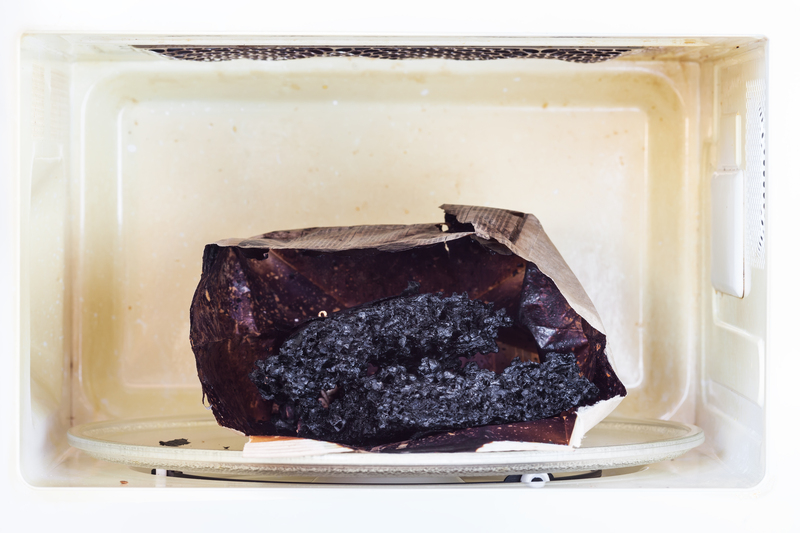Banish Grease for Good: Master the Art of Cleaning Enamel Oven Trays
Posted on 04/10/2025
Banish Grease for Good: Master the Art of Cleaning Enamel Oven Trays
Enamel oven trays are kitchen essentials that bear the brunt of high temperatures, bubbling cheese, roasting juices, and stubborn burnt-on residue. If you're tired of battling with grease-stained oven trays that refuse to come clean, you're in the right place! This comprehensive guide will help you master the art of cleaning enamel oven trays once and for all, so you can restore their pristine shine and keep them looking like new.
Understanding Enamel Oven Trays
Before diving into advanced cleaning techniques, it's helpful to understand what makes enamel trays unique. Enamel is a smooth, glass-like coating fused onto metal--often steel or cast iron. This surface is highly resistant to heat, scratches, and corrosion, but it can be vulnerable to harsh abrasives and sudden temperature changes.
- Benefits: Even heat distribution, non-reactive surface, attractive finish, easy to clean with the right methods.
- Challenges: Susceptible to chips, stains, baked-on food, and grease buildup if not maintained.

Common Issues with Dirty Enamel Oven Trays
Enamel oven trays are robust but not invincible. Over frequent use, you may encounter:
- Baked-on food residue: Food particles hardened from repeated heating.
- Persistent grease stains: Oily splatters that burn into the surface.
- Discoloration: Staining from intensely colored foods or carbon buildup.
- Chipping: Harsh scrubbing or temperature shocks can crack the enamel.
Addressing these issues immediately after every use helps but sometimes, life gets ahead of us. The good news? With the right knowledge and gentle determination, you can bring even stubbornly dirty trays back to life.
Essential Supplies for Cleaning Enamel Oven Trays
Before you embark on your cleaning mission, assemble these must-have supplies:
- Soft sponges and cloths: Avoid abrasive scrubbers that can scratch the enamel surface.
- Dish soap: A high-quality, grease-cutting detergent is essential for daily maintenance.
- Baking soda: This gentle abrasive lifts stubborn residues without damaging enamel.
- White vinegar: Natural degreaser that helps dissolve mineral deposits and grease stains.
- Plastic or wooden scraper: For prying off stubborn bits without scratching.
- Non-scratch scouring pads: For extra cleaning power when needed.
- Oven cleaner (as a last resort): Enamel-safe versions only!
- Gloves: Protect your hands, especially if using stronger cleansers.
The Step-By-Step Process: How to Clean Enamel Oven Trays Like a Pro
1. Act Fast: Clean While Warm
Whenever possible, clean your enamel oven tray right after cooking. Warm trays are much easier to clean, as grease is still soft and food hasn't fully hardened. Never pour cold water onto a hot tray as it can cause thermal shock and chip the enamel.
2. Remove Loose Debris
First, scrape off any leftover food with a plastic or wooden scraper. Wipe away crumbs with a damp cloth.
3. Soak for Stubborn Stains
Place the tray in your sink and fill it with hot (not boiling) water and a generous squirt of dish soap. Let it soak for at least 30 minutes--if stains are especially stubborn, leave overnight. This process helps to loosen baked-on grease and residue.
4. The Baking Soda Boost
Baking soda is your secret weapon for removing grease from enamel oven trays. Sprinkle a thick layer of baking soda over the surface, then drizzle on a small amount of white vinegar. Allow the mixture to fizz for several minutes. Scrub gently with a damp non-scratch sponge in circular motions, focusing on tough spots.
5. Rinse and Inspect
Rinse the tray thoroughly with hot water to remove all soap and baking soda residue. Inspect for lingering stains.
6. Repeat or Escalate (if needed)
If stubborn grease or burnt bits persist, repeat the baking soda-vinegar process, or try the following:
- Baking Soda Paste: Mix three parts baking soda with one part water into a paste. Apply directly to stains, let sit for 15-30 minutes, and scrub gently.
- Enamel-Safe Oven Cleaner: Follow product instructions carefully. Ensure all residue is removed after cleaning to protect your food and the enamel coating.
7. Dry Thoroughly
Dry your enamel oven tray completely with a soft cloth. Air drying can sometimes leave water spots, so patting with a towel is best.
Extra Tips: Maintenance to Keep Trays Grease-Free
- Use a liner: Consider parchment paper or a silicone baking mat to catch drips and make cleanup easier.
- Wipe spills immediately: When possible, wipe away greasy spots soon after cooking, while the pan is still warm but not hot enough to burn.
- Regular deep cleans: Schedule a monthly deep clean with baking soda and vinegar to prevent buildup before it becomes a problem.
- Avoid abrupt temperature changes: This prevents chipping of the enamel coating.
- Store properly: Stack trays with a cloth or paper towel between them to avoid scratches.
What to Avoid When Cleaning Enamel Oven Trays
Not all cleaning methods are created equal. Protect your trays by never using:
- Abrasive steel wool or metal scrubbers: These can scratch and wear away the enamel coating, making stains harder to remove in the future.
- Harsh chemical cleaners: Only use oven cleaner specifically labeled as safe for enamel surfaces.
- Scouring powders: Many contain gritty minerals that are too harsh for enamel.
- Sudden, extreme temperature changes: Don't rinse a hot tray with cold water or place it in the freezer--a rapid temperature shift may crack the enamel.
Eco-Friendly and Natural Cleaning Methods
If you'd rather avoid chemical cleaners, here's how to clean enamel oven trays naturally:
Lemon and Salt Scrub
- Cut a lemon in half and sprinkle baking soda or fine salt onto the cut side.
- Use the lemon as a scrubber all over the tray, squeezing gently as you go.
- This not only removes grease stains from enamel oven trays but deodorizes, too!
Boiling Water Bath
- If possible, place the enamel tray on your stovetop with a few inches of water and a dash of baking soda.
- Bring to a gentle simmer for ten minutes--heat helps loosen really stubborn, burnt-on grease.
- Let cool slightly, then clean as usual.
Addressing Tough Stains and Burnt-On Grease
Sometimes, despite your best efforts, enamel oven trays develop tough, blackened stains from roasted meats, baked cheese, or sugary foods. Here's how to tackle even the worst messes:
Baking Soda & Vinegar Paste Method
- Mix equal parts white vinegar and baking soda to create a thick, foam-like paste.
- Apply generously to burnt spots or heavy grease.
- Cover with foil or cling film and let sit for a few hours (or overnight for extreme cases).
- Remove the covering and scrub using a nonabrasive pad. Rinse well.
Commercial Enamel Oven Tray Cleaners
- Choose a cleaner specifically designed for enamel surfaces.
- Always follow manufacturer instructions for application and rinsing.
- Test on a small, inconspicuous area first to ensure compatibility.
Hydrogen Peroxide and Baking Soda
- Mix enough hydrogen peroxide with baking soda to form a paste.
- Apply to stubborn, greasy, or burnt-on stains and let stand for an hour.
- Wipe away with a soft sponge and rinse well.
How to Store and Prolong the Life of Your Enamel Oven Trays
- Keep trays dry: Moisture can corrode edges over time, so always store enamel trays dry.
- Protect the surface: When stacking, use a paper towel or cushion to prevent scratching the enamel.
- Avoid using metal utensils: These can damage the glossy finish and encourage food to stick.

FAQ: Your Enamel Oven Tray Cleaning Questions Answered
Can I use a dishwasher for enamel oven trays?
Most enamel trays are technically dishwasher safe, but hand washing is gentler and extends their lifespan. The dishwasher's high water pressure and abrasive detergents can cause micro-scratches over time.
What removes burnt-on grease from enamel oven trays most effectively?
A baking soda-vinegar soak or a hydrogen peroxide-baking soda paste are the most effective natural methods. For extreme stains, an enamel-safe oven cleaner may be necessary.
Is it safe to use bleach on enamel oven trays?
It's generally not recommended--bleach can dull the finish and, with prolonged contact, may damage the enamel.
Conclusion: Shine On with Spotless Enamel Oven Trays!
Banishing grease for good from your enamel oven tray doesn't require fancy tools or harsh chemicals--just a little know-how, patience, and elbow grease! Employing the gentle yet effective methods above, you'll keep your trays spotless, sanitary, and ready for countless more delicious bakes.
- Always avoid abrasives and harsh cleaners.
- Embrace baking soda and vinegar--your kitchen's cleaning dream team.
- Develop a routine cleaning habit for best results.
With these strategies, you're well-equipped to master the art of cleaning enamel oven trays and ensure their gleaming finish lasts for years to come. Say goodbye to greasy, stained trays--your oven (and your next meal) will thank you!



